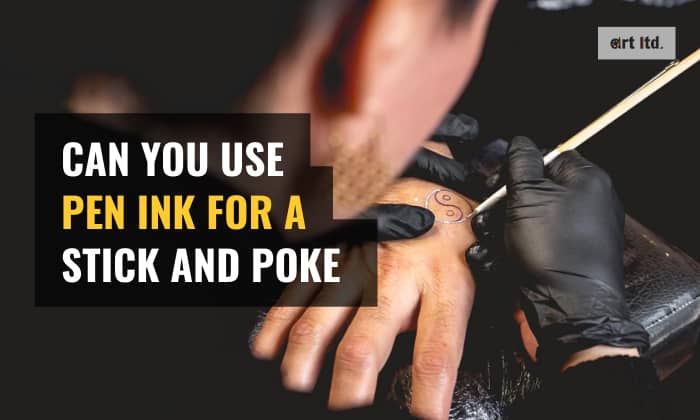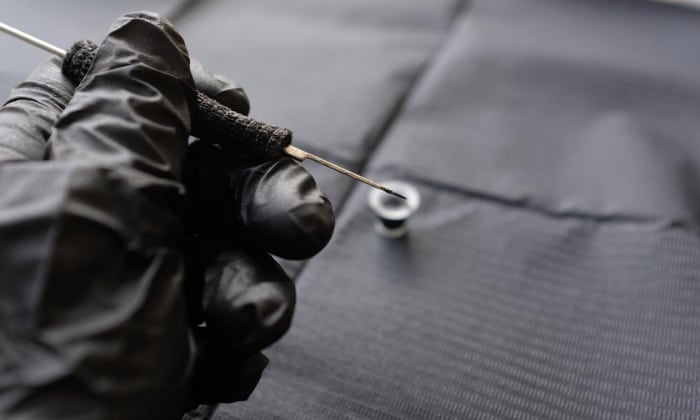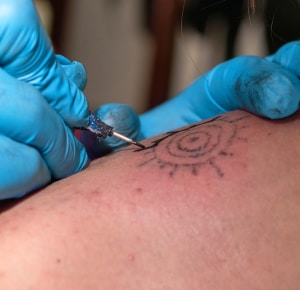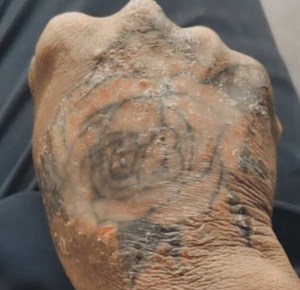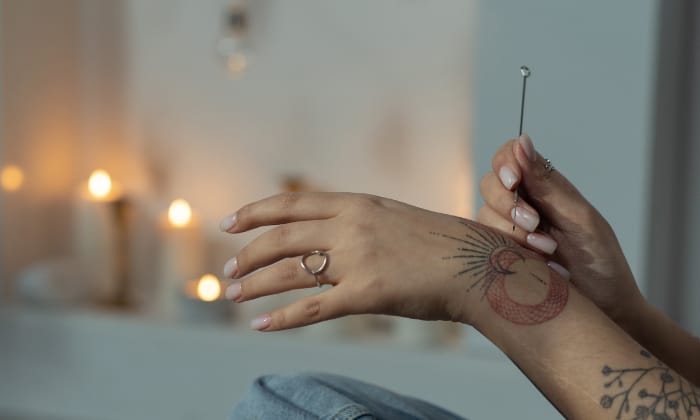Can you use pen ink for a stick and poke? Yes. But it is not recommended to do it because of potential health risks and complications.
Stick-and-poke tattoos have gained popularity, but it’s crucial to understand the risks and considerations involved when using pen ink for such tattoos. Keep scrolling to learn more about the long-term effects, concerns, and suggested alternatives.
Table of Contents
Can You Do a Stick and Poke With Pen Ink?
Yes. You can use pen ink for a stick and poke, but you should not do that due to its toxicity and lack of sterility.
The harmful chemicals in the ink (lead, chromium, nickel, etc.) can be dangerous for your skin, and there is no guarantee of long-lasting or fading results.
1. Safety concerns and risks
Is pen ink safe for stick or poke tattoos? No. Pen ink is not formulated or intended for use on the skin.
It lacks the necessary properties and ingredients for safe application. Thus, using pen ink to do any stick or poke may pose a significant risk to your health and safety. Below are what happens to you when having a pen ink tattoo:
- Allergic reactions: Using pen ink can trigger allergic reactions in some individuals, leading to redness, swelling, itching, or even more severe symptoms.
- Infection risk: Since pen ink is not sterile, it can introduce bacteria and other pathogens into the skin, increasing the chance of infections.
- Bloodborne pathogens: Pen ink is not sterile and may come into contact with blood during tattooing. It can transmit bloodborne diseases such as HIV, hepatitis B, or hepatitis C if precautions are not taken.
- MRSA: Methicillin-Resistant Staphylococcus aureus, a bacteria that is resistant to some antibiotics, is challenging to treat and may cause serious complications.
MRSA infections usually appear as skin problems like boils or abscesses, but they can also lead to more serious infections in other parts of the body. Common symptoms include redness, swelling, warmth, pain, and the formation of pus in the infected area.
- Other risks: Ink poisoning can lead to various symptoms, including joint pain, headaches, increased body temperature, stained skin, stomach upset, nausea, and vomiting.
2. Potential complications of using pen ink
- Inflammation and swelling: The risk of inflammation increases due to the non-sterile nature of fountain pen ink or any other ink type. Inflammatory responses can lead to swelling, pain, and heat around the tattooed area, prolonging healing.
- Tissue damage: Pen ink’s improper formulation and composition can be bad for your skin and have underlying tissues. Excessive trauma caused by the tattooing process, along with the use of non-professional ink, can lead to tissue damage.
3. Long-term effects on skin
- Pen ink cannot stay permanently on the skin. Because most fountain pen inks are dye-based, they can dissolve in body fluids like blood and plasma from a tattoo site.
- Thus, the small dye particles don’t stay in the skin cells for long and are quickly washed away by the bloodstream. It will fade quickly, blur, or change color over time on the skin.
4. Pros and Cons of Using Pen Ink
- Cost-effective: Using pen ink to give yourself a tattoo can be a cost-effective option compared to purchasing professional tattoo ink.
- DIY creativity. Because stick-and-poke tattoos can be done at home with basic tools, you can express your creativity and create unique designs.
- Safety concerns and uncertain longevity.
- Limited color options: Pen ink typically offers limited color choices compared to professional tattoo inks, which may restrict the creativity and desired outcome of the tattoo.
Alternatives to Pen Ink for Stick and Poke Tattoos
- Tattoo ink: Professional tattoo ink is specifically formulated for skin use and undergoes rigorous testing for safety and quality. It is available in a wide range of colors and ensures better longevity and color retention than pen ink.
- India ink: India ink is another popular stick-and-poke ink alternative because it is non-toxic, cheap, and provides decent tattoos. Some common India ink types are Speedball, Higgins, Winsor & Newton, and Pelikan Fount.
- Organic and Vegan tattoo ink: You can consider plant-based inks because they are natural, with little to no synthetic products. Their ingredients usually contain logwood for black, naphthol for red, and sodium for blue.
Besides, a non-toxic pen ink usually includes purified water, witch hazel, and Listerine.
Some popular vegan tattoo ink brands include Eternal Ink, Kuro Sumi, MOM’s, and Dynamic.
Frequently Asked Questions
How Long Do Stick And Poke Tattoos Last?
On average, stick and poke tattoos tend to last anywhere from 5 to 10 years depending on the below factors:
- Technique: A properly executed stick-and-poke tattoo with sufficient depth and ink saturation may have better longevity.
- Tattoo aftercare: Keeping the tattoo clean, moisturized, and protected from excessive sun exposure can help preserve the tattoo’s appearance.
- Location: Areas subjected to frequent rubbing, friction, or exposure to the elements may experience faster fading.
- Ink quality: Professional tattoo inks generally have better color retention and longevity than non-traditional ones.
Can I Remove A Stick And Poke Tattoo?
Yes, it is possible to remove a stick-and-poke tattoo, but you should let a trained professional do it. Professional tattoo removal techniques, such as laser tattoo removal or surgical excision, can effectively remove the stick and poke tattoos.
Avoid DIY methods or homemade tattoo remedies such as coconut oil, creams, or lemon. They can lead to complications, scarring, or ineffective results.
Tips To Do Stick-And-Poke Tattoo DIY
- Safety first: Wear disposable gloves, use sterile needles, and work in a clean and sterile environment to minimize the risk of pen ink infection.
- Maintain cleanliness: Keep the work area, tools, and skin clean. Use alcohol swabs and wipes as needed.
- Be aware of pain sensitivity: Different body areas may have varying pain sensitivity levels. Adjust your technique accordingly.
- Take breaks: Give yourself and the skin breaks to rest. Assess the tattoo’s progress and make touch-ups as needed.
- Proper aftercare: Apply a recommended aftercare balm and follow aftercare instructions to promote healing and prevent infections.
Tips For A Safe Stick And Poke Tattoo Experience
- Prepare the skin: Shave and clean the tattoo area with soap and water. Avoid applying any lotions or creams before tattooing to prevent interference with the ink.
- Go slowly and gently: Take your time and apply light pressure when poking the needle into the skin. Avoid forcing the needle or going too deep, as it can cause unnecessary pain, damage, or scarring.
- Seek professional help if needed: If you encounter any difficulties during the process or experience signs of infection or complications after tattooing, consult a professional tattoo artist for guidance and proper care.
Conclusion
Can you use pen ink for a stick and poke? The answer is you should avoid doing it. Pen ink is not formulated for use on the skin and may contain toxic substances that can lead to various complications and risks.
Instead, choose professional tattoo inks or safer alternatives designed for stick-and-poke tattoos. Your health and safety should always be the top priority when considering any body modification.

Art has always been a part of my life; it influences my upbringing and later my career choice. For me, it is always a part of my parenting technique. So for whichever purpose that you come to art, you can start here with us.
